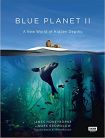Blue Planet II by James Honeyborne and Mark Brownlow
You may well remember when the sticking of a number '2' after a film title was suggesting something of prestige - that the first film had been so good it was fully justified to have something more. That has hardly been proven correct, but it has until recently almost been confined to cinema - you barely got a TV series worthy of a numbered sequel, and never in the world of non-fiction. If someone has made a nature series about, say, Alaska (and boy aren't there are a lot of those these days) and wants to make another, why she just makes another - nothing would justify the numeral. But some nature programmes do have the prestige, the energy and the heft to demand follow ups. And after five years in the making, the BBC's Blue Planet series has delivered a second helping.
You could call the original ground-breaking, if that was even the right phrase (better, I dare say, than water-breaking). And this book claims just the same - from drone pilots credits for the top-down look at animal activity, to cameras stuck to the sides of whales that pick up previously unknown behaviour. The science seen in the programmes will be just as cutting-edge as that which made it - you will have fish returning to use the same coral clump to crack open its clams, you will see dolphins spit water over and behind fish so they're scared right into their mouth by the splash, and you will have a fish point to prey it can't reach, so that its octopus friend will flush it out for the two to fight over.
The superlative world of the creatures is matched by the fifty-metre long kelp fronds, as one chapter here concentrates on the aquatic plant life that is a vital part of the whole system. And the book (and programme) proves it is all one system, as every sea is connected to every other - plastic ducks floating in the Pacific when their shipping container broke open and sank in a storm have reached the UK shores. It's a system we're systematically wrecking, however, and the final chapter with its evidence of plastics pollution and climate change will force many a reader to need a stiff drink. I know it did me, for the sour taste it leaves in the mouth - it really is galling.
As for the book, it is also a superlative. It's one of the key books for general science, for nature, for biology in photos, for whatever you care to label it, this year. Will it sell? Well, people both watched and bought Delia Smith when she was at her peak, and people won't just sit on their couches in their millions to absorb only the TV series. On previous evidence, I won't assume every chapter here equates to one of the TV episodes (none of which have been broadcast yet as I write this), although some of the titles would appear to match up. The balance of the book is a mixture of the main episodes, and those DVD-extra-styled addenda they put out immediately after, concentrating on the making-of and/or the research. Therefore here you get a lot of the nature and science from the programme, but unlike the main episodes the creators and their craft, their thoughts and experiences, and off-screen incident are all allowed to feature. It's a good balance.
What I would say about the writing is that it's a little too bitty for me - previous books of this kind have had the same number of chapters but more of a narrative flow. Here practically everything is subdivided into two- or four-page spreads, which have the habit of stopping and starting, even if the next section is the logical continuation up the food chain to the next animal. It also relies on too much googling, with lots of Scrabble-proof animal names, and terms like the 'lateral line', that go without definition or explanation. (It also has enough minor typos for me to mention them, perhaps a sign of it being forced on the shelves in time for transmission.) But that's a little churlish to say, for this is as review-proof as nature books get. Were this cookery it would be Delia, or Jamie, or very few others; were it for kids it would be a Walliams. It has that prestige, and will have those kinds of sales.
I must thank the publishers for my review copy.
Planet Earth II by Stephen Moss is the previous exception to the 'no numbered sequels' rule. You will also enjoy the book that coincided with The Hunt by Alastair Fothergill and Huw Cordey.
Please share on: ![]() Facebook,
Facebook, ![]() Twitter and
Twitter and
![]() Instagram
Instagram
![]() You can read more book reviews or buy Blue Planet II by James Honeyborne and Mark Brownlow at Amazon.co.uk Amazon currently charges £2.99 for standard delivery for orders under £20, over which delivery is free.
You can read more book reviews or buy Blue Planet II by James Honeyborne and Mark Brownlow at Amazon.co.uk Amazon currently charges £2.99 for standard delivery for orders under £20, over which delivery is free.
You can read more reviews or buy Blue Planet II by James Honeyborne and Mark Brownlow from Amazon.com
Comments
Like to comment on this review?
Just send us an email and we'll put the best up on the site.

